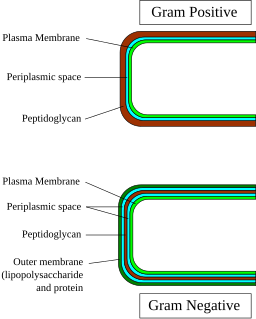- Summary
- Constraints
- Positive Remarks
- Errata Everywhere
- The Focus-Distraction Spectrum
- Curriculum
- Educational Enshittification
- Conclusion
- References
Summary
I had the priviledge of working as a teacher last year. Though I would not count a short year as “substantial” experience in middle school education, I could not help but notice the horrific quality of textbooks in natural scences.
In this article, I will recollect some examples from the textbooks I was given. I provide comparison to an older book and a contemporary youtube channel, thereby trying to identify the cause of the lack of quality. And I identify shortcomings in the curriculum as a partially related issue.
To summarize my main observations:
- The schoolbooks I worked with are full of simplifications, inaccuracies, and plain errors. Critically, they structurally lack references, which could somehow remedy the simplifications by linking to more extensive treatment of topics.
- Modern textbooks are made to be catchy and entertaining to appeal to the youth, which amplifies the issues. Textbooks are proprietary goods in a competitive market, which creates financial incentives for quick output; they have to incorporate changing curricula quickly.
- There are fundamental, persistent flaws in the curricula, such as the lack of or late coverage on Molecular Orbitals, Coulomb Force, and Evolutionary Theory.
Highlighting these structural deficiencies in my sample from the educational literature landscape, I suggest that free and open source, community-maintained school textbooks might be a valuable alternative to the products of “big” publishers.
Constraints
The past year, I have been working as a middle school teacher here in Belgium, giving a variety of lessons to children aged 14-17 in a local middle school. My personal background is in the subject, not in the pedagogy. However, I did not have the feeling of being totally incapable of “classroom management” (what a horrible term), inclusion, or general treatment of kids. In fact, I felt quite well in my place.
The content of the lessons was easy, topics superficially covered various concepts of natural sciences, which I was well familiar with from my general and deepened studies in biophysics and biology. Yet the amount of lessons on my personal agenda, and the lack of lesson repertoire, made preparation challenging.
… which is where schoolbooks would come in handy. Ideally, a good course book should guide the students through the topics, provide links to material, and facilitate the creation of high quality lessons.
The one I used was selected by my predecessors: they chose WACO by Plantyn publishers [1-4]. There are others, such as the GENIE series by VAN IN [5]; and I think another publisher’s effort is circulating, the name of which I cannot recall or find at the moment. [In other countries, there are other publishers, so please do not uncritically assume that my observations generalize.] Having worked with GENIE briefly the year before, I would say that the book market is rather homogeneous, though the general quality of GENIE seems minimally superior. This homogeneity is no surprise: books need to connect to the “leerplan”, the centralized curriculum. That curriculum is established by the local government to implement some overarching European guidelines on what the majority of European pupils have to learn by a certain age, to become good Europeans (note: if you feel annoyed by my excessive use of the word European, feel free to replace it a gusto by “the party”, “working class”, or “capitalist”/“socialist”; resemblance is co-incidence).
Important to point out is that Flanders saw a major curriculum revision recently, which is why all of those books are rather recent. One would think that any novel revision should incorporate all the latest knowledge and science with reasonable accuracy, and that its content is surely presented better than in any predecessors. Which is not the case, in my opinion.
For both publishers I considered herein, the main content-providing textbook (“leerboek”) is flanked by a workbook with exercises (“werkboek”). Both are accessible as an online e-book, which is essentially a commentable PDF (with extra form fields for template solutions in the workbook). The digital version is web-based and, in my opinion, technically immature.
Positive Remarks
Despite my criticism to follow, there are some positive aspects which I guess one can like about the books. I want to list those before turning to the problematic facets.
- Topicality: Both publishers put considerable effort in attempting to connect the more or less abstract content to students everyday life (“actualiteit”). Whether this effort is succesful or not is to the taste of the user.
- Design: WACO has an appealing comic style and uses song titles from ancient times to headline their chapters (e.g. “Born to be Wild” for human sexuality, “Circle of Life” for ecosystems).
- Connection: they occasionally draw interdisciplinary connections, yet unfortunately this is mostly restricted to parallel curricula using similar figures in books from different disciplines.
- Media: the books link to media (though, quality is an issue, see below).
- Exercises: The accompanying workbook holds an extensive set of exercises (quality is an issue) and the publishers even provide tests and evaluation sheets for teachers (mostly unusable, in my opinion).
- Structure: The feature I appreciated most are summary boxes, highlighted areas at the end of each sub-chapter which recollect the major coverage.
These points are debatable, which I tried to indicate. There is one which I would argue is unnegotiable, and that is factual quality.
Errata Everywhere
Factual Quality
All the fancy-schmancy layout, links, examples, design, and illustration could not cover a lack of the fundamental requirement for each and every school textbook: the mentioned facts must be accurate, logical, and verifyable. After all, we want our children to be smart and knowledgeable, right?
In contrast, the schoolbooks I encountered were full of faults and shortcomings. I will provide examples from all my disciplines, and suggest improvements.
Observations
Example: Kinetic Energy
Take this exercise from the physics workbook [3], ch.1, p.71.

A question on the mechanic energy of three different vehicles; [3], ch.1, p.71.
The kids are presented three different vehicles, and asked for the one with the highest kinetic energy.
Of course, they are supposed to recall that kinetic energy depends on mass and velocity (\(E=\frac{m}{2}\cdot v^2\)). Yet velocity is in there with a square relation. And there is no indication of any measured velocity on the images. So the answer given by the exercise book (blue text) is clearly wrong: it should rather be the omnipotent “it depends”.
Asking for energy difference in the static images is like asking which side of the earth receives more light from the sun. The question and answer are roughly related, yet we miss context. I see a considerable danger of shaping wrong intuitions in pupils, by dissociating concepts, contributing factors, and constraints. Students could have learned so much more here by adding just a little more maths.
Example: Intrinsic Energy
In the chapter about thermodynamics, students learn about the internal kinetic and potential energy, and how temperature relates to the kinetic part. As an introductory exercise to attract their intuition, they get the following [3/werkboek, ch.4 p.156]:

Frappucino forces; [3], werkboek, ch.4 p.156.
The last of the multiple choices asks whether the mutual attractive forces of the particles are higher in warm coffee or ice coffee.
I remotely get the logic of the simplified particle model which they are attempting to implement here. Particles move quicker with higher temperature. Tempting to think that on average they are at a higher distance. And thus the distance-dependent attractive and repulsive forces might be lower.
But is that really so? After all, the reason for the particle distance is that there are repulsive forces, impulse transfer at short range; there is temporal variation and occasionally those huge caffeine molecules will be rather close to each other (maybe even closer than in cold state, because they bump with higher inertia).
And then there is action-reaction: forces, in sum, should be zero. Do they mean force or energy? I think the book points at energy here, because that concept is related to warmth and tempereature. Yet energy is, of course, related to force by work, i.e. the path matters. This makes the question unexpectedly complex, and I wonder whether that was intentional by the workbook authors. I would not dare to assess the relation of temperature to force in this complex situation, and the multiple choice form does not account for the multitude of possible perspectives to be discussed here.
Example: Convection
Continuing on thermodynamics, students learn about heat transfer, with three major modes: conductivity, convection, radiation. They suddenly face a snowman standing in front of a (metal) oven [3/werkboek, ch.4 p.162]:
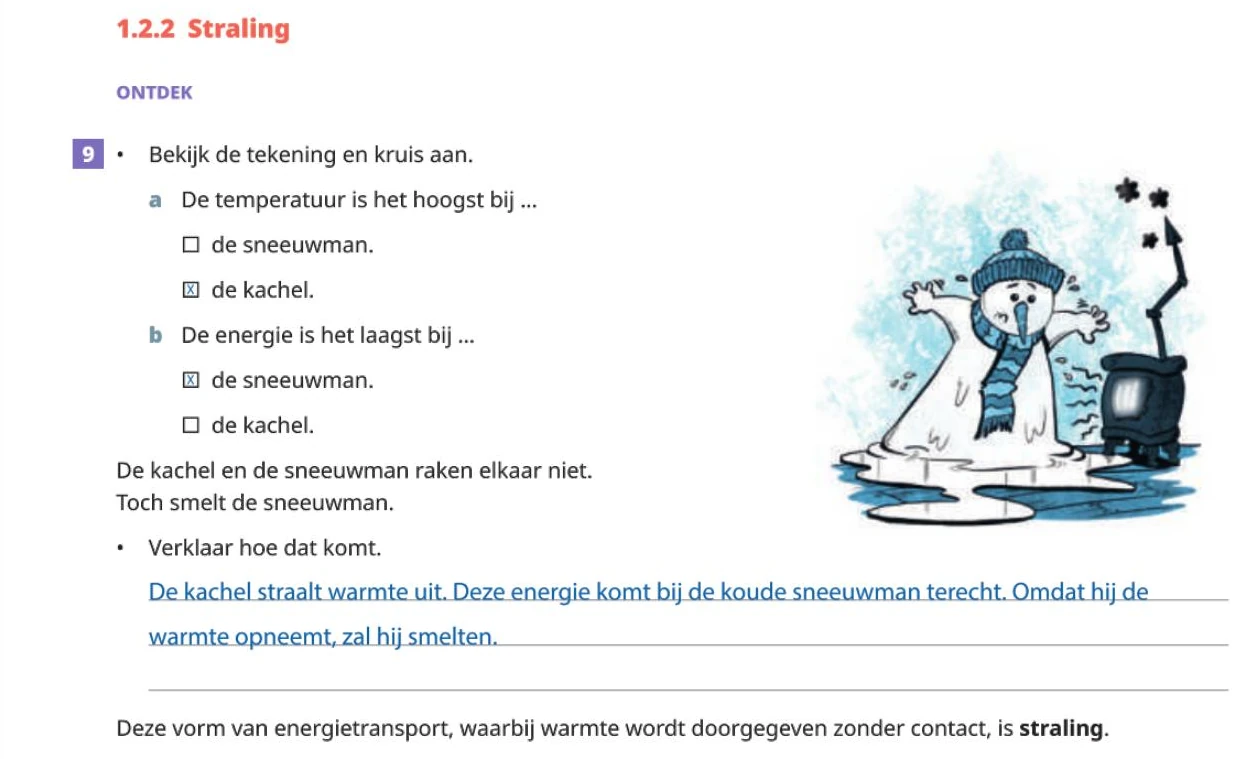
No snowman ever melted without convection; [3] werkboek, ch.4 p.162.
The results provided by the book wants the students to exclusively focus on radiation in the given setup. I would prefer my students to see conductivity (the oven), convection (the air), and yes also radiation. I would argue that we could design experiments to support the hypothesis that convection is the most efficient of the three in the given situation.
And I am sure that those experiments have been done. However, the book never gives any references, neither to quantitative radiation studies, nor in fact to any of their content.
Example: Elelctroscope
Occasionally, correct (but brief) explanations from the textbook [3, ch.3, p.69] only partially make it to the workbook. One example is the working of an electroscope [3, ch.3, p.114], an instrument which can detect charge, indifferent to the sign of the charge.
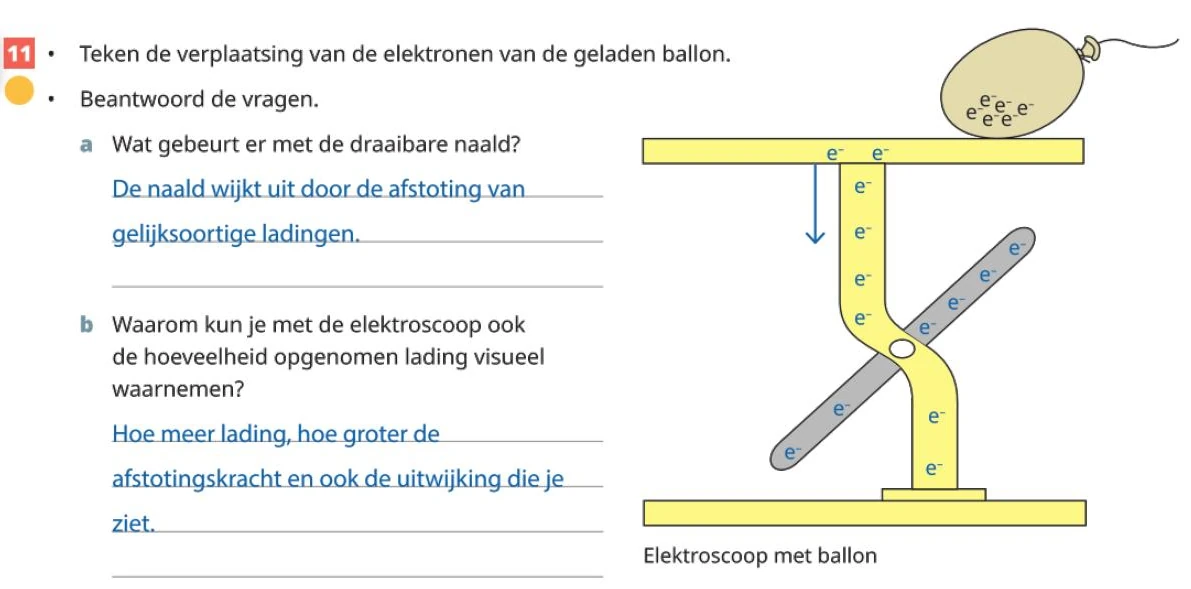
The ambiguous electroscope; [3], ch.3, p.114
I only realized ex post that this insufficient answer, paired with a misleading arrow, which most of my students copied hastily and revisited later (as is their bad habit), has led to quite a lot of missing points on their examn. I can totally understand that they missed (i) that there is no direct force from the balloon to the needle, and that (ii) contact is not necessary, electrons simply redistribute within the metal device as a result of Coulomb’s Force. This is an example of sub-par quality figures, which there are a lot, with another example to follow.
With minimal effort, I have improved the figure from the book for my tests.

The less ambiguous electroscope; own work
In general, the book (and ultimately the students) would have benefitted from the coverage of Coulomb’s Force, which re-activates their understanding of force from classical mechanics, and is fundamental to electrophysics. I think this issue is caused by the mandatory, but non-ideal curriculum requirements, as I will discuss below.
Example: Primordial Cell Components
Here comes another example of an inaccurate figure, this time from the biology textbook [1, ch.2, p.32]. Students are introduced to the chemical components of life by considering a primordial cell in the primordial soup.
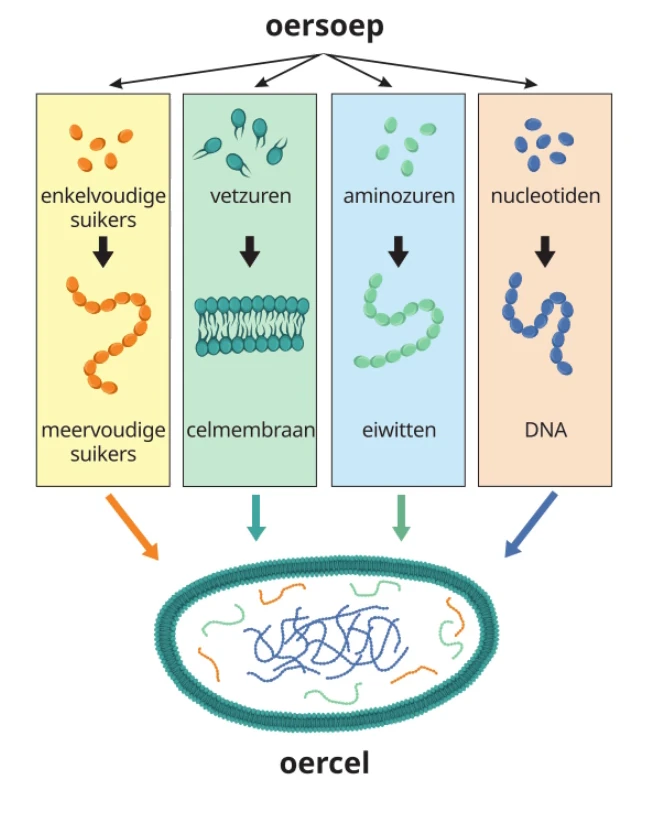
Primordial soup of homogeneous blobs; [1] ch.2, p.32.
Note how all the arrays of dots look alike for the different compound classes. I think this figure benefits greatly from using the conventional symbols for organic monomers, rather than uniform, colored blobs.

Primordial soup of relevant components; own adaptation.
… unless of course we assume that too much realism will confuse the students. Too many symbols might indeed be confusing, and it is on the teacher to tell them that they need not know by heart. I would argue that just seeing the symbols will support memory formation and association later.
Will a student ask about the four letters on nucleotides? Sure!
Do we appreciate that curiosity? Absolutely!
Example: Polarity
This is one of the major flaws of the WACO 4 “Chemistry” textbook, and on this example I know for sure that the GENIE is superior to the WACO. In fact, WACO falls short here of covering what is required by the curriculum for this topic.
Here is what the curriculum requires [6]:

There is a related curriculum point related to intermolecular forces, all of which WACO handles on less than three lousy pages.
What the book should cover is a good bit of content about bond polarity and electronegativity [7], extending the kids’ understanding of metal bonds, and realizing that the ionic character of a bond is on a continuum. GENIE identifies two cutoff values [14, p.141] for polar bonds ($\Delta EN > 0.5$) and ionic bonds ($\Delta EN > 1.6$), and based on fig. 8.4.6 in the libretext linked above and other recources [8], I would call those reasonable.
WACO, on the other hand, dives into the topic by characterizing water as follows [2, ch.3, p.51]:

Water is life. And it has two symmetry planes. [2], ch.3, p.51.
The authors decided to focus on symmetry, and claim that water has only one symmetry plane (which is wrong: it is tetrahedral, with two pairs of corner constituents, so there are two planes of symmetry; in the figure above the second symmetry plane is defined by the three constituent atoms). They identify any bond between different elements as polar, by setting the electronegativity threshold to zero. This is in conflict with experimental evidence (compare here, and here) and thus plainly wrong.
WACO continue to pentane, and claim that the symmetry of the C-H arrangements leads to non-polar character of the compound. I would argue that this is false: the single bonds are quite mobile and wobbly (symmetry is not permanent), and instead non-polar character of the bonds ($\Delta EN \approx 0.4$) leads to the non-polarity of the compound. For completenes and the sake of discussion, I provide the complete page [2, ch.3, p.52]:
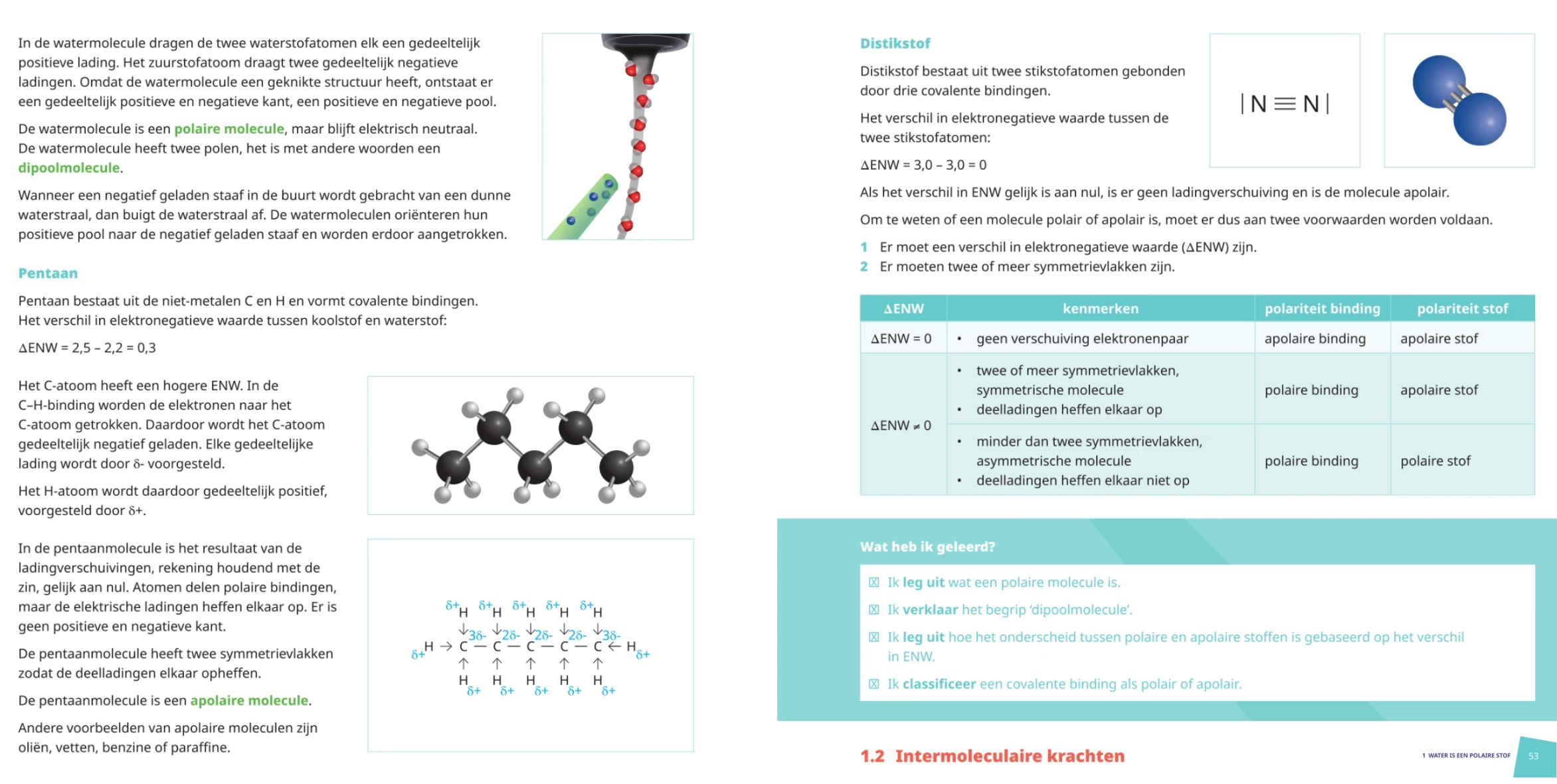
Polarity in organic compounds - more debatable than one would think. [2], ch.3, p.52.
My students had learned from my predecessor to draw clouds of charge distributions around Lewis structures to determine symmetry. This is a nice, haptic skill for elementary level, but given that those structure formulas are an idealized 2D projection of a complex situation, it won’t bring them to higher insight. What remains is a clear conceptual discrepancy between me and the WACO in why, for example, most carbon-hydrogen-compounds are non-polar and hardly soluble in water. The crucial difference is that I can reference literature resources.
The lack of accuracy and insight in this chapter continues towards the treatment of intermolecular forces, which are actually all just Coulomb Force [8]. Students are left off worse than before reading the book, because they have to unlearn drawing clouds around alkanes next year.
This one is definitely a point to blame on the authors and publishers of WACO 4 Chemistry. Either they themselves lacked knowledge of the underlying principles and conventions. Or they intentionally simplified, but unintentionally introduced flaws. Or there is a parallel school of chemistry which I, and the GENIE authors, are unaware of.
Note that, in any of the sketched cases, a simple link to literature references could have clarified the situation, and improved the quality of the book.
Example: Linked Media
In the very first biology chapter [1, ch.1, p.10] on human sexual behavior, pregnancy, and influencing factors, there are several links to external resources which could be considered “enrichment” (if they were useful). However, the quality of the material is underwhelming.
An example that was not to my taste, I would even say irrelevant due to its design, is a video about morning sickness during early pregnancy.
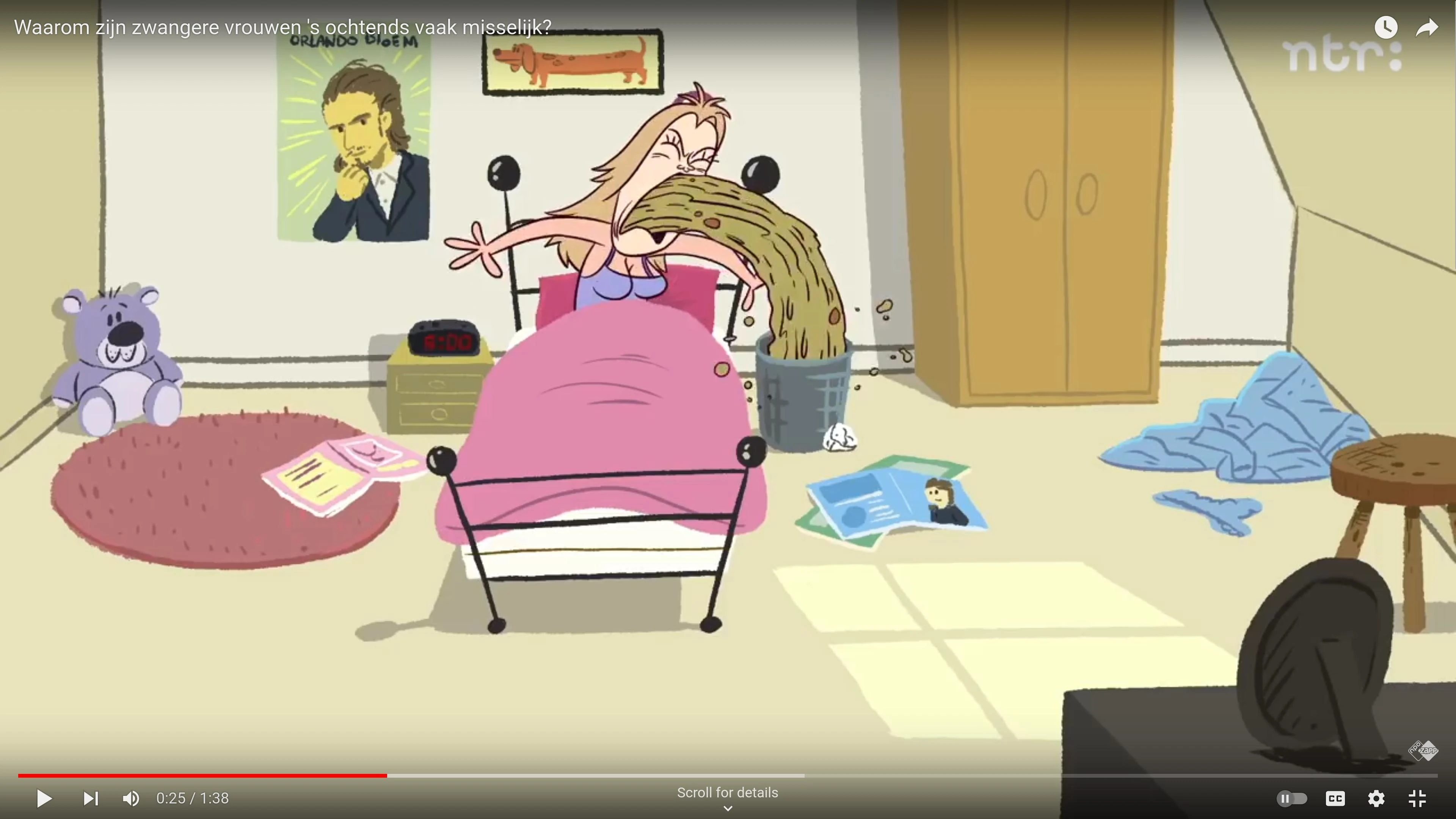
Morning sickness / illustration. Note that regurgitation supposedly has nothing to do with the Orlando Bloom poster. https://www.youtube.com/watch?v=Gl48N1Iz4qM
Furthermore, the first two pages linked to:
- a user instruction video by a pregnancy test manufacturer (with ambient music, of course); trivial, but necessary.
- a recording of a 2007 broadcast of a 3D animation of fertilization; emphasis: a recording (including timeline and mouse pointer), because Plantyn did not succeed in asking VRT (the staten television provider) for video access rights.
- further web “resources” with manufacturer websites and low resolution, low quality images.
For me, the vast majority (or even the entity) of web links were unusable, the provided content would have been a waste of lesson time. I would call these links “enpoverment”, the opposite of “enrichment”, because they would have lowered my lesson quality upon use.
Extract: Points of Critique
To condense the major patterns from my above observations:
- Text and images are often inaccurate or erroneous, superficial, low quality.
- The same standards apply to “non-enriching” weblinks.
- Topicality, i.e. the link to everyday phenomena, is implemented excessively and somewhat carelessly - and gets outdated yearly (like Orlando Bloom; sorry, man!).
- Oversimplification prohibits deeper insights.
- Lack of coverage beyond the curriculum can be a hinderance.
- Some chapters deviate from or fall short of the central curriculum.
- Bibliography is omitted entirely.
I assembled an incomplete list of errata above to support my argument. These were left “top of my head” after a year of teaching, yet in fact there was weekly frustration with the material I had to work with. The errata are WACO-specific; yet I also remember and you can evaluate for yourself whether VAN IN/GENIE provide an advantage.
Errata are normal. Lack of quality can be a symptom of a tight production/publishing schedule. Yet I think there is more at hand, and would like to evaluate further. Therefore I will to dissect some of the observed issues below.
Scientific Method
I think it is worth to once more poke on the lack of literature references, with another enlightening example.
Throughout the biology textbook [1], WACO mentions exponential growth.
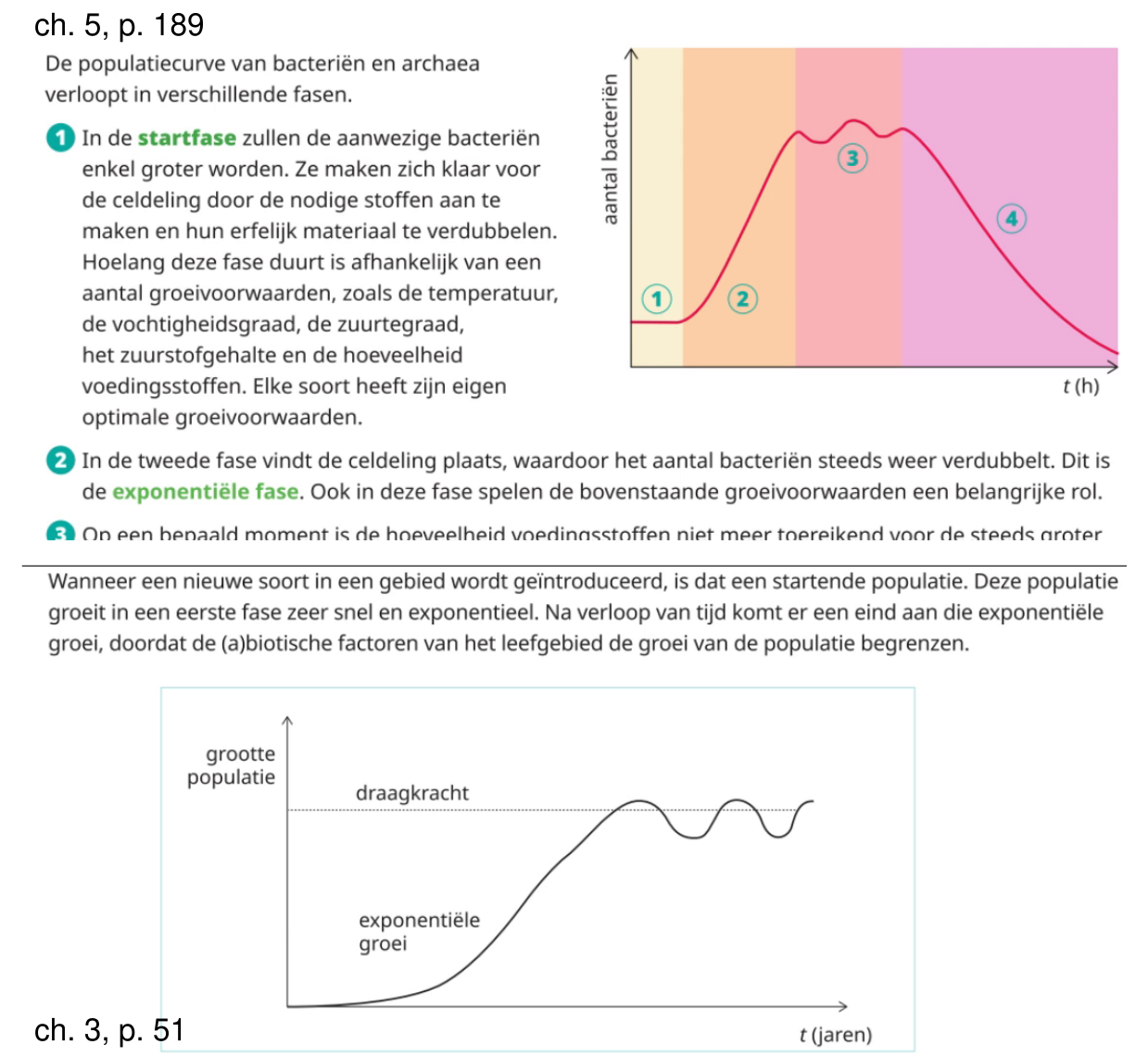
Do you see the problem with these figures?
Maybe if I contrast my own version of it:

I see several crucial issues in the above.
(1) Discrepancy with maths. The curve is not exponential. The authors missed the axis label. This is in conflict with what students learn or are supposed to learn in maths. If we talk about “exponential growth”, students must see exponential curves. If you copy, at least do it correct.
(2) Plagiarism. The authors of WACO fail to reference the original creator of the figure [9]. As far as I can tell, the figure from that publication is not openly available, the publication is not referenced, hence this qualifies as plagiarism. Reminder: Plantyn makes money with the schoolbooks. If you copy, reference correctly.
(3) Discrepancy with Original Authors. Even worse: the original authors identified six phases of bacterial growth; the book only mentions four; “lag” and “start” are clearly confused. If you copy, at least do it correct.
(4) Style. The WACO version is uselessly colorful and ugly. Granted, this is their “style”.
Are adjustments difficult to implement? No.
Do they matter? Absolutely!
The unambiguous target group of the book are kids who are prepared for university (“doorstroomfinaliteit”). Our future Belgian doctors and professors. Schoolbooks must adhere to good scientific practices. Not plagiarizing is one of the low hanging fruits in this regard.
Let me hook on the “style” aspect for a second.
The Focus-Distraction Spectrum
Style or Distraction?
At some places the book is colorful, artworks on chapter pages are appealing, so what is wrong with a bit of different style?
You see, I added the point above to distract you from the fact that there were factual errors and plagiarism. “Style” can be quite distractive. And in fact, the books are completely distractive, front to end.
I cannot imagine how bad these books must be for people with a perception filter disorder.
To clarify my point, let me draw the focus-distraction spectrum based on two limiting cases.
Observations
One End: “Wissensspeicher”
One of the oldest reference schoolbooks available to me personally is “Wissensspeicher Physik” (translated by google scholar as “Knowledge Repository Physics”) [10]. This is a popular East German book from 1975. It is not supposed to be used as a textbook, but an accompanying, lexicon-style resource (people born before google and wikipedia will remember what lexicon means).
I actually used it on one or two lessons to get a first overview on topics which I hadn’t taught before. I also remember my physics professor, Prof. Benson, at HU Berlin, to use it as a dielectricum to demonstrate capacitor properties in physics lectures; I think he made a remark that that was the only purpose left for the old book. Yet, seeing and having to work with WACO, I keep asking myself whether or not Wissensspeicher would be a valid fallback option, despite the downfall of socialism and my audience not speaking German (neither of which matters for physics classes).
The series is quite iconic; anyone who grew to take physics classes in the GDR probably knew it. The biology cousin of my physics book even achieved an award for being one of the most beautiful books of the GDR in 1980 (socialist realism, I guess). Fun fact: the “Wissensspeicher” is available for purchase again on a major German publisher, and it is still backed by the same authors; it survived a system change, which tells you something. Cult status manifests in the price of now 32.25 EUR (used to be 8.50 Ostmark; approximately 2 EUR at most unfavorable exchange rates).
For comparison: the WACO books are above 25 EUR (textbook) + 15 EUR (workbook) on studieshop.be where my students were obliged to order; ten times the price of the original Wissensspeicher.
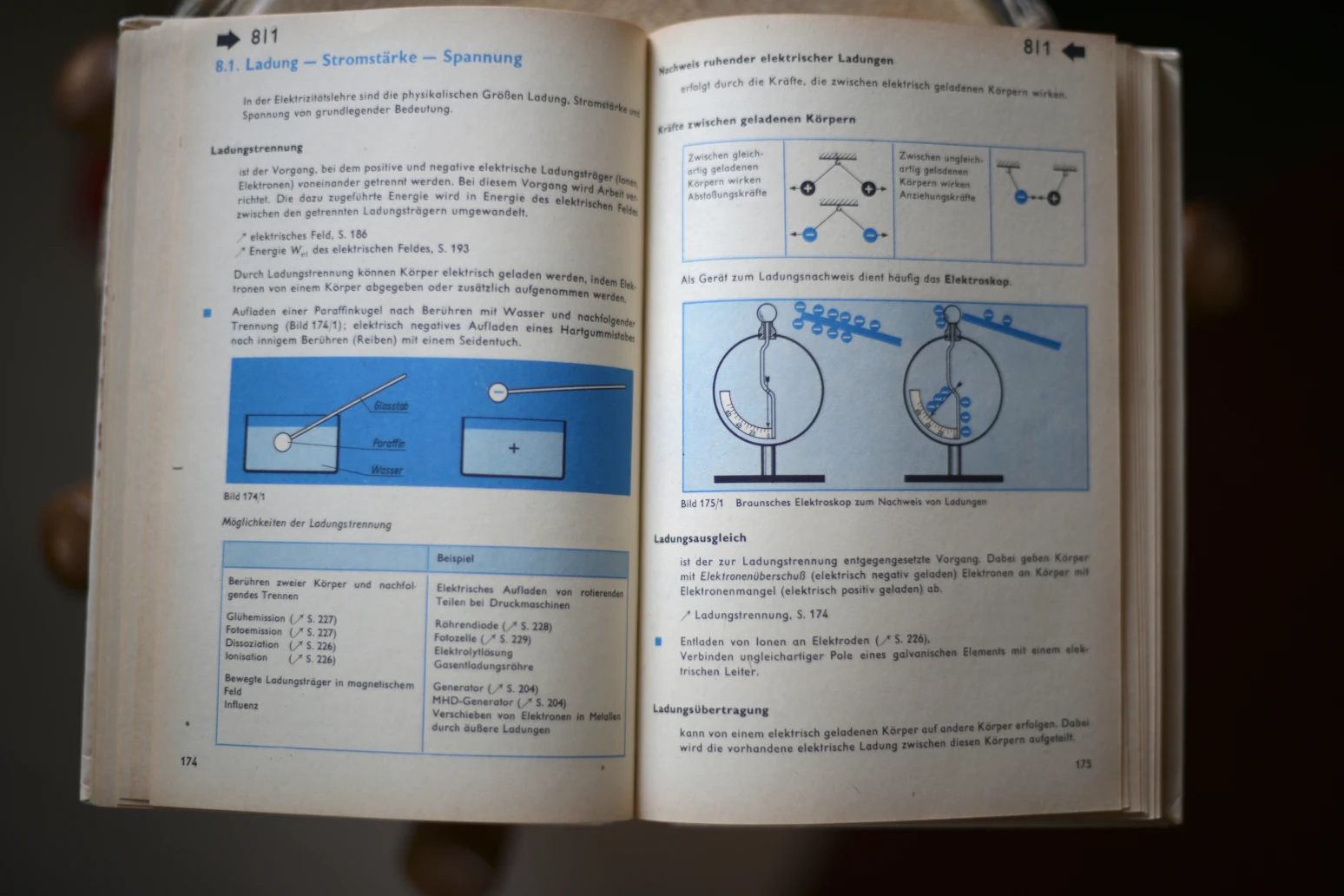
The least ambiguous electroscope; "Wissensspeicher Physik" [10], p.174.
Compare the depiction of an electroscope in Wissensspeicher to the one in WACO (further up): it is clear, labeled, unambiguous, stylish, high resolution.
And that is the general pattern in the Wissensspeicher. No distraction. Clear guidemarks to each topic from under the front cover. Logical structure of the chapters. Well-thought tables, figures, and text boxes. One-pagers on most relevant concepts. Cross references in the book. Literature references in the appendix (though with a historic focus). The book lacks examples and exercises, but that should anyways be helped by a complementary exercise book, an must be tailored to the audiences’ capabilities.
From the anecdotes above you might think that Wissensspeicher Physik is some laughable anachronism. Looking at it today, I would rather assess that this fifty year old book is a timeless gem. The reason being that it offers high information density, with minimal to no distraction, and it is still mostly up to date for the basic physics topics.
The Other End: Amoeba Sisters
On one of the topics for which I prepared lessons, WACO had a video link to “The Amoeba Sisters”. Though I did not use it, this was one of the better weblinks.
At that point I had the epiphany, which remains to be my current working hypothesis, that the only source WACO authors had for their work on the science books are youtube videos. Give this a thought!
The Amoeba Sisters are a self-employed team of influencer sisters [11]: one with a background in biology, the other drawn to graphical design and cartoons. They seem to be around since about 2013, viewcounts rising.
Here a few frames from their video about bacteria:

The Amoeba Sisters; https://youtu.be/ORB866QSGv8
Attempt a dry analysis of one of their videos: content-wise, it seems accurate. Distraction-wise, it is questionable (poppy visuals, irrelevant anecdotes, limited generalization). They focus on a single main line of thought, aggregate facts, and turn them into a series of memes. Suitable for youtube, yes.
Their selling point is to “demystify science with humor and relevance” [11]. One can argue about whether “demystification” is the right word. One can discuss about relevance. Yet the success of these videos is phenomenal. They doubtlessly represent what high school teachers think would be appealing to their pupils.
I personally find the comic style too distracting. I would argue that a microscopic image here and there would be beneficial. But I highly appreciate that the sisters provide references in the video description! There are handouts on their website, yet those are not free.
I remember some controversy about the simplified language and behavior of teletubbies when that subadolescent entertainment show reached my local television. I would dare to call the amoeba sisters the “teletubbies for adolescents”. They display the comic world as it really is: entertaining, some resemblance to ourselves, not entirely detatched from scientific facts. In contrast to their own claims, I would guess that they get viewers primarily through entertainment; education is a side goal. On the focus-distracting-spectrum, I see them on the distracting end.
Teletubbies for Adolescents?!
One may debate which balance to strike between the extremes. Is it not good that the Sisters create attachment, interest, and lock-in for the biological sciences? Should we not appeal to the target audience? Yet I called that end “distraction”, and not “appeal”, for a reason: those are different criteria. You can have appeal without distraction, and distraction is problematic.
Let me illustrate that point. Throughout last year, students kept asking me time and time again what they would have to rehearse or know for a test. Despite my best intention to give clear outlines and well-structured lessons, they fail to distil the essence of novel information (which is normal). They clearly have trouble filtering the relevant facts, and this trouble is strongly emphasized by magazine-like texts, illustrative photos, and uptempo videos.
I have the feeling that many publishers attempt to compete with “social” “media”, with the everyday feeds of the youngsters, to be hip and entertaining.
Is that really necessary? Think of you parents using “hip” and modern words, like “hip” or “chill”. The line between “appealing” and “awkward” is thin. And what might be appreciated now will certainly be awkward next year.

Beyonce is not outdated, but has probably "re-invented" herself a couple of times since "bootylicious"; [1], ch.2, p.30.
For example, the fly named after Beyoncé [1, ch.2, p.30] might have been “boodylicious” in 2001. I doubt that any of my students has any relation to or memory of that song. Mental note: next year, someone please ask them to whistle the melody.
Keep in mind: many kids carry their figurative backpack of learning complications, along with the general packages of anhedonism, peer pressure, and intermittent neglect (due to parents media habits). Maybe we should not enkindle that explosive by catering to entertainment. Kids can benefit from a little structure, factuality, reliability; and I think “demystifying science” (sensu amoebus) starts by providing actual facts, real images, and the recurrent invitation to autonomously imagine abstract concepts. Maybe we would have fewer adults debating the existence of measles if more adolescents would have seen the electron micrographs of the virus at school?
My intuition tells me that we have strayed too far from the “focus” end, and should try to start a corrective manoevre.
Entertainment and Quality
The spectrum mentioned above seems to co-incide with a temporal gradient. The Wissensspeicher was one of the oldest repositories I turned to, the Amoebas are rather up to date. Yet that is a false impression.
Recapitulating my general critique about WACO: the trend I observe is not only about “focus”, it is also about quality. I have further, general evidence. When looking up an example for Gram staining, google images retrieved a lot of rubbish; among the better ones there is the obligatory wikipedia scheme.
Compare this to the image from the “Campbell” [12], a standard for first year university biologists:

Gram staining, explained by a University level textbook; [12], fig. 27.3.
It occurred to me that, just as in the Wissensspeicher, every single text and figure in the Campbell seems of high quality, and well thought through. The book has good structure, is comprehensive, and covers contemporary applications. Two books from two different political systems showing the same degree of quality - this cannot be co-incidence!
Why do contemporary school textbooks fail to compete with old books, or with University level literature? Maybe the authors use google. Google just crawls around for some images related to the topic. Those can be kids’ drawings or satirical imitations; google doesn’t know. Google finds many images. Generally, the absolute minority of those are appropriate for my search intention.
When going back to actual textbook illustrations, I realized how bad the internet search results we use every day have eventually become.
Could this be the hideous face of enshittification, as coined by Corey Doctrow?
Curriculum
Model Choices
I have followed a relatively uncommon educational trajectory for someone teaching in Belgium. My own education took place in Germany, where I also passed my general study programs. I enriched those with online lectures selectively.
A different educational background should not change the basic principles of the natural sciences. However, it does change your perspective, and the choice and specific details of the models we use might differ.
Those choices are fixed in the curriculum. The curricula of biology, chemistry, and physics have in common that their structure at times seems a little twisted.
Observations
Molecular Orbitals
If I remember correctly, the very first lesson I gave was third year (age thirteen/fourteen) chemistry about the history of atom models. The book and my lesson would start with Dalton and Thompson, to finish off with Rutherford-Bohr and the electron shells. It is great that the curriculum has an emphasized agenda point to teach kids what a scientific model is, how it changes over time, that we adjust our world view based on accumulating or conflicting experimental evidence. However, I think that in this case the majority of kids rationalize this as historic progression, and take the final model as the truth.
And consistently it turns out that those Bohr shells are quite sticky. They facilitate the introduction of the Periodic Table, shortly after: you can couple columns to valence electrons and rows to the number of shells. Students learn to draw a nucleus and fill shells around it. Trouble comes if you stumble over the transitional metals. The numbers of valence electrons written in roman letters atop our PSE’s get confusing, things don’t make sense anymore. And, unfortunately, few of our students draw the connection that such inconsistencies require model adjustment.
When I was looking for chemistry books to have an analogue material repository to guide my lesson design, I somehow got drawn to N.J. Tro’s “Chemistry - A Molecular Approach” [8]. As the other non-schoolbooks I mention here, it is highly recommended: its macro-structure, micro-structure (i.e. figures and tables), as well as the exercises are well designed.
That book takes a different approach: it introduces molecular orbitals early on. It then builds on the orbital concept to introduce more basic phenomena such as electron movement and probability, electron density distribution, bonds and electronegativity. Those ideas would much facilitate the discussion of polarity, bond formation, reaction types just a year later. And they give an application for otherwise detatched maths they learn in parallel.
Though I understand that molecular orbitals touch on higher concepts from particle physics, I find it a missed opportunity that we save molecular orbitals for later schoolyears, instead of mentioning and outlining them up front. Noone expects students to immediately grasp a complex theory. But carefully mentioning them can help to draw connections, facilitates the elimination of misconceptions, and kindles interest to read further. At least keep them critical about the working model: any model is just food for our next revolutionary hypothesis.
Coulomb Force
One volatile subject during the recent curriculum reform has been electrophysics. Not volatile in coverage, but in timing: here in Flanders, it was now decided to teach it at age fourteen to fifteen.
And who better to consult for a good curriculum design than the great Walter Lewin? At least, that’s where I learned Maxwell’s Equations (at the time accompanying a great analogue lecture received by Prof. Martin zur Nedden, HU Berlin).
Can you start to even talk about charges without mentioning Coulomb’s Force? Apparently yes: WACO can, and GENIE 4 Fysica can as well. And searching through the leerplan does not yield any result either, so it might not be on the publishers this time.

TikTok challenge: try teaching electrophysics without mentioning Coulomb force.
Coulomb Force is the basic reason why charged particles “feel” each other, why they move, why we have an electric field. We choose to leave the force out and jump directly to the effects (though “field” is also omitted, unfortunately). Is this a good choice? Certainly not!
If you jump into a topic without establishing basic principles, students will not get a good foundation for their understanding of the world. It is like learning to drum, but clasping your fingers tight around the drumsticks: you will get out a rhythm eventually, but will not be versatile at it; and re-learning to eliminate bad habits takes considerable effort. As mentioned above, Coulomb force connects their knowledge of force, work, and energy (which was covered in classical mechanics) to the new topic. I do not say that we immediately have to cover all details of the electric constant and the structure of the equation. Yet some foresight and a little more math would greatly benefit the students’ understanding, now and later. I assure you, they have the capacity, if we tease them right (positive motivation, curiosity). Remember how curious we ourselves were at school - sometimes. Electricity is one of the most fascinating shows of experimental physics.
Whereas I could accept that molecular orbitals are left out for historic reasons and simplicity, I have no acceptance for omitting Coulomb Force from the physics curriculum.
Evolution
Chemistry and physics have these major flaws in their curriculum, and it seems as if biology was determined to trump them.
Why, oh why, is the great concept of evolution not part of the textbooks of fourteen-year-olds? It is an insult to twohundred years of science that this concept is almost completely omitted from biological education. Evolution makes a brief appearance in the chapter on “Biodiversity”, as one of the features of life. There is one box with an image of Darwin’s famous tree scribble. However, the rest of that “biodiversity” chapter cries “evolution” from every corner (tree of life, descent with modification, struggle for existance), but magically avoids to explicitly mentioning the theory or its inception.
Granted: I taught in a Catholic school, and the majority of our audience have muslim background (Paradox? Not at all!). I see that the topic requires some framing as a scientific theory, which should not interfere with their religious beliefs. And I get that, globally, some regions have a different opinion about this. But here in Belgium, even pre-school books mention evolution. The kids have long heard about it. They appreciate that a teacher takes the time to formalize their hear-say knowledge. This saves us time to eliminate misconceptions later on. And they much benefit from the idea when it comes to other topics, such as microbiology, sexual behavior, (functional) anatomy.
There are more “missed opportunities” and topics which appear not or far too late in the curriculum, e.g. DNA, plasmids, and conjugation in the context of microbiology. Yet omitting the theory of evolution is an epic lapse. It degrades Biology, a respectable branch of science, to a “learning-by-heart”, “keeping-them-occupied” waste of resources.
Lacking Fundamentals
In conclusion, it appears to me that the responsibles are missing opportunities time and time again to provide logically consistent curricula. The examples above have in common that fundamental elements of our working hypothesis world view are only covered after more derived concepts. In my opinion, this significantly complicates teaching those subjects. Conversely, when I rudimentarily covered Molecular Orbitals, Coulomb Force or Evolution in my lectures, I saw immediate improvements to the level of insight that the kids would achieve.
Let me give an example from one of my classes. I had vaguely mentioned evolution and explained the principles when they asked me on the topic of the “seven features of life”. At a later point, talking about unfavorable life circumstances and extremofiles, one of the students realized by themself that micro-organisms evolve rapidly due to their short generation times, and brought this up for a good discussion. That then turned out to provide a lot of explanatary power for the omnipresence of bacteria and archaea, for the handling of pathogens, et cetera. They immediately understood that non-pathogen bacteria thrive in symbiosis with their hosts (co-evolution). Instead of learning by heart that “bacteria are everywhere” and “most bacteria are not harmful”, they would say “well, isn’t that obvious?” Conversely, kids who don’t internalize these connections are at higher risk of leaving the class with a negative attitude: “okay, I learn now that bacteria are harmless and everywhere, but I still find them disgusting and hopefully on me there are not so many”.
If you lack the fundamentals, knowledge is built upon sand. You foster blind obedience instead of critical, autonomous thinking. It must be considered an unfortunate co-incidence that the curricula of every major discipline of natural science suffers from questionable design choices.
Educational Enshittification
Open, Modular Books
Assuming that the potential and character of showmasters (teachers) and audience (kids) has not changed over the years, the most likely cause of the decay is market competition and publishing pressure. In Flanders, the recent reform has trickled down pressure to the workfloor to cover the new arrangement of topics in a meaningful way, in a short time. This is no small task: educational topics are inductive, and interdependent. Changing one for the other may involve major friction. We had a reform. We have missed an opportunity to set the curricula right.
But the consecutive issues are partially caused by the market players who provide the books. Openly available, modular books (“free and open source”, FOSS) could offer a robust solution.
At first glance, it might seem surprising that open online books are rather rare, and have not made it to school programs. Examples for higher education exist, including libre texts and open stax (links here to the respective biology sections). Yet maybe the low abundance is no surprise. There are significant hurdles which need to be adressed. Those include hurdles in terms of payment structure (free work of the authors), quality control (though peer review is included by the teacher on the workfloor), or linguistic barriers (my students can occasionally digest single English sentences, but much prefer the local tongue). And there is a risk of missing goals of the curriculum; unfortunately those goals are binding to educational institutions.
I attempted an example of a FOSS book myself for my computer science lessons: a python coursebook, written and usable in logseq. It has a rather modern, associative structure with many crosslinks, and might therefore not be as useful as a linear learning guide. Yet with the sidebar and a teacher to provide navigation, with complementary exercises, and with some room for student creativity, such online coursebooks can easily replace PDF boardbooks. Besides, knowledge managers such as logseq and roam are relevant tools for students and teachers to master. My book has not found much resonance beyond my own classroom, and maybe the writing is as mediocre or cryptic as the present piece. Yet in general, associative forms can increase connectivity among the sciences and link to external resources. Their open nature allows correction if they miss the curriculum. They aggregate, and stay accessible if provided free of charge.
Of course, such solutions would entail immediate financial loss to the currently ruling publishers, so it is unlikely that they will not fight the change.
Knowledge Isn’t Ours Any More
Thinking about the financial situation of publishers, it appears that their business model has undergone quite an evolution.
When I was at school, I remember that books were loaned and cared for. They would be loaned for free, but with the obligation to replace damaged ones. Note that this is about textbooks; for workbooks and worksheets, loaning makes no sense.
The textbooks my students have nowadays are loose sheets or paperback at best; low quality color prints, just as it might fit for a workbook. The internal quality of these perforated paper collections is thus reflected on the outside. This is a logical step: since all kids have weak back musculature yet are equipped with a windows “surface” computer, the print has become irrelevant and even unwanted. The kids pay for paper and digital access. Yet the digital access is revoked after a year. Even for teachers, by the way. We had a discussion this year about whether to continue with WACO or switch publisher. If I understand it correctly, subscriptions are paid school-wise, and contracts last for a couple of years. Internally reluctant, I did not think that switching will fix fundamental flaws, and most colleagues opted for WACO (which would lead to problems with parallel classes and migrating pupils), so sadly we chose to all continue with WACO.
But I personally never received a printed book. My digital licenses are tied to my “smart”-“school” account. This means that the material I used and that my school paid for will be gone shortly; another clear characteristic of the enshittification process. After all, I should be glad that book quality was inferior (so no chance that I will miss it), and I take the subscription madness as a bonus argument for FOSS schoolbooks.
For the publishers, this is the cash cow situation. You create a book, and license fees stream in each year. The three times 40 EUR per head for the full science WACO stack is an obscene price for something that will last a year. Students have no chance to avoid it, they are not a free market participant. The offerings of different publishers are indistinguishible. Even the boardbook PDF interface (called “diddit” and “scoodle”) is technically equivalent. Honi soit, qui mal y pense.
Just as computers aren’t ours any more (see also here, or here), we have also lost ownership on educational material.
Conclusion
The observations above indicate that the status quo of contemporary school textbooks is a “Frankenstein monster” of misplaced external influences.
- Our current curricula are historically burdened and intellectually impeding, despite many recent chances of meaningful reforms.
- We have converted paper books to mimic them in the digital space. For example, we have retained a linear, non-interactive structure that was typical for non-encyclopedical paper.
- We imitated features of online attractions to gain fake appeal to youngsters, lifting the anchor of scientific accuracy to get there. Like placing a rollercoaster on the school playground, no safety belts or personnel.
- All that comes decorated with wicked subscription models which reduce customer rights while raising publisher profits.
- Yet in fact we still operate lousy software implememtations for PDF-like boardbooks, which have no favorable purpose in classroom situations.
I would argue that it is due time to re-think educational literature.
Starting from the efforts which good teachers all over the globe invest to turn the existing book rubbish into usable lessons, a free and open online repository for courseware might be a good start; micro-payments might incentivize the use and maintenance. Those efforts must be guided by the strive for scientific accuracy, at least for the kids on a university-directed trajectory. I am sure such online repositories already exist, yet they are not widely accepted (a situation in favor of the publishers). This would justify a comparative analysis of causes and potentially prohibitive flaws, but since I am leaving the educational profession, I did not put effort into further research. Finally, re-thinking educational literature would also require a certain flexibility in the curricula, both in terms of the amount of topics covered per lesson time (room for extension and creativity), as well as in the choice and order of topics.
My observations above are limited to two series of textbooks in the natural sciences on the Flemish educational landscape. I cannot exclude that other fields, other languages, or other publishers provide better material. The three major problems I observed and discussed are (1) the horrific quality of educational material provided by publishers, (2) the tendency to confuse entertainment and education, and (3) systematic flaws in the order and choice of covered topics. The general tendency to digitize without evidence of a positive effect [13] is evident, and in consequence, conditions on the working front are frustrating for all participants.
And as you read, I share a lot of the frustration. My greetings and best wishes go to all the colleagues who are still out there trying to navigate the young minds through these dangerous times.
Thank you for reading, and as always, please send comments!
References
- [1] J. Goussey, A. Karsmakers, E. Kenis, M. Sanne, E. Vanoutrive (2022): “WACO Biologie 4”, Plantyn nv., België; ISBN: 978-90-497-0348-6
- [2] A. Bongaerts, V. Damm, G. De Deken, I. De Veuster (2022): “WACO Chemie 4”, Plantyn nv., België; ISBN: 978-90-497-0351-6
- [3] R. Berckmoes, G. Broeckhoven, A. Deboeverie, K. Drossaert (2022): “WACO Fysica 4”, Plantyn nv., België; ISBN: 978-90-497-0354-6
- [4] R. Berckmoes, A. Bongaerts, G. Broeckhoven, V. Damm, A. Deboeverie, G. De Deken, I. De Veuster, K. Drossaert, J. Goussey, A. Karsmakers, E. Kenis, M. Sanne, E. Vanoutrive (2022): “WACO Natuurwetenschappen 4”, Plantyn nv., België; ISBN: 978-90-497-0356-6
- [5] N. Vandamme, B. Coopman, G. Verschoren (2022): “Genie”, VAN IN nv., Wommelgem, België; e.g. “Fysica 4” ISBN: 978-94-641-7451-9
- [6] Curriculum (“leerplan”) Natuurwetenschappen II-NatS-d 2023/2024, Katholiek Onderwijs Vlaanderen, accessed July 2nd, 2024
- [7] Bond Polarity and Electronegativity. (2023, July 7). https://chem.libretexts.org/@go/page/21748
- [8] N.J. Tro (2021): “Chemistry - A Molecular Approach”, Pearson Global Edition, 5th ed.
- [9] J. Monod (1949): “The growth of bacterial cultures”; Annual Review of Microbiology, vol. 3, no. 1, pp. 371–394; doi: 10.1146/annurev.mi.03.100149.002103
- [10] R. Göbel, P. Schulze, R. Plötz, H. Buscherowsky, E. Eichler, W. Damm, P. Glatz (1975): “Wissensspeicher Physik”, Volk und Wissen, Berlin (3. Auflage)
- [11] https://www.amoebasisters.com
- [12] Campbell Biology Global Edition (9th ed., 2011); Fig. 27.3 “Gram staining.”, p. 603; Pearson
- [13] cf. J. Balslev (2020) “Evidence of a potential: The political arguments for digitizing education 1983-2015.”, PhD Thesis; https://jesperbalslev.dk/evidence-of-a-potential-ph-d-thesis
- [14] authors unknown (2022): “Genie 4 Chemie”, VAN IN nv., Wommelgem, België; available here: https://issuu.com/uitgeverijvanin/docs/600379_genie_chemie_kov_4_lb_150dpi_watermerk
